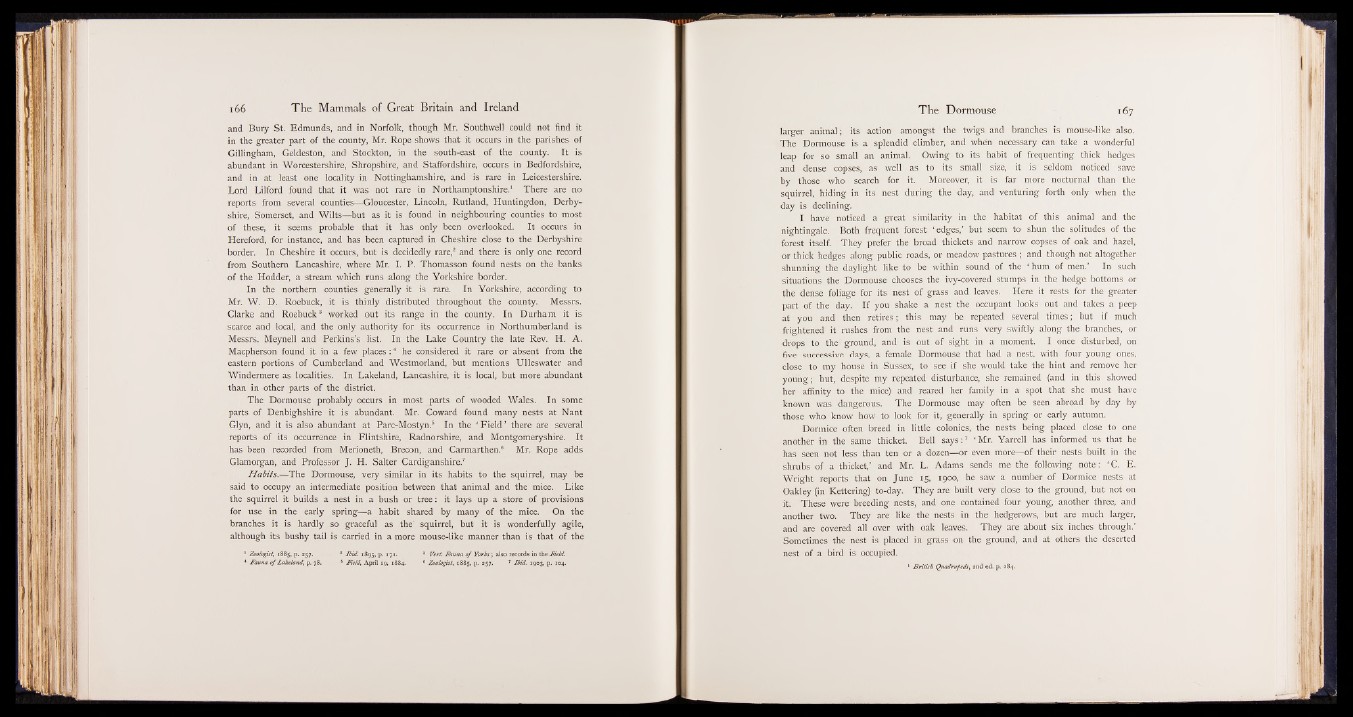
and Bury St. Edmunds, and in Norfolk, though Mr. Southwell could not find it
in the greater part of the county, Mr. Rope shows that it occurs in the parishes of
Gillingham, Geldeston, and Stockton, in the south-east of the county. It is
abundant in Worcestershire, Shropshire, and Staffordshire, occurs in Bedfordshire,
and in at least one locality in Nottinghamshire, and is rare in Leicestershire.
Lord Lilford found that it was not rare in Northamptonshire.1 There are no
reports from several counties—Gloucester, Lincoln, Rutland, Huntingdon, Derbyshire,
Somerset, and Wilts—but as it is found in neighbouring counties to most
of these, it seems probable that it has only been overlooked. It occurs in
Hereford, for instance, and has been captured in Cheshire close to the Derbyshire
border. In Cheshire it occurs, but is decidedly rare,2 and there is only one record
from Southern Lancashire, where Mr. I. P. Thomasson found nests on the banks
of the Hodder, a stream which runs along the Yorkshire border.
In the northern counties generally it is rare. In Yorkshire, according to
Mr. W. D. Roebuck, it is thinly distributed throughout the county. Messrs.
Clarke and Roebuck8 worked out its range in the county. In Durham it is
scarce and local, and the only authority for its occurrence in Northumberland is
Messrs. Meynell and Perkins’s list. In the Lake Country the late Rev. H. A.
Macpherson found it in a few places: 4 he considered it rare or absent from the
eastern portions of Cumberland and Westmorland, but mentions Ulleswater and
Windermere as localities. In Lakeland, Lancashire, it is local, but more abundant
than in other parts of the district.
The Dormouse probably occurs in most parts of wooded Wales. In some
parts of Denbighshire it is abundant. Mr. Coward found many nests at Nant
Glyn, and it is also abundant at Parc-Mostyn.6 In the ‘ Field ’ there are several
reports of its occurrence in Flintshire, Radnorshire, and Montgomeryshire. It
has been recorded from Merioneth, Brecon, and Carmarthen.6 Mr. Rope adds
Glamorgan, and Professor J. H. Salter Cardiganshire.7
H abits.—The Dormouse, very similar in its habits to the squirrel, may be
said to occupy an intermediate position between that animal and the mice. Like
the squirrel it builds a nest in a bush or tree: it lays up a store of provisions
for use in the early spring—a habit shared by many of the mice. On the
branches it is hardly so graceful as the’ squirrel, but it is wonderfully agile,
although its bushy tail is carried in a more mouse-like manner than is that of the
1 Zoologist, 1885, p. 357. * Ibid. 1895, p. 171. 3 Vert. Fauna o f Yorks; also records in the Field.
* Fauna o f Lakeland, p. 78. 5 Field, April 19, 1884. 0 Zoologist, 1885, p. 257. 7 Ibid. 1903, p. 104.
larger animal; its action amongst the twigs and branches is mouse-like also.
The Dormouse is a splendid climber, and when necessary can take a wonderful
leap for so small an animal. Owing to its habit of frequenting thick hedges
and dense copses, as well as to its small size, it is seldom noticed save
by those who search for it. Moreover, it is far more nocturnal than the
squirrel, hiding in its nest during the day, and venturing forth only when the
day is declining.
I have noticed a great similarity in the habitat of this animal and the
nightingale. Both frequent forest ‘ edges,’ but seem to shun the solitudes of the
forest itself. They prefer the broad thickets and narrow copses of oak and hazel,
or thick hedges along public roads, or meadow pastures ; and though not altogether
shunning the daylight like to be within sound of the ‘ hum of men.’ In such
situations the Dormouse chooses the ivy-covered stumps in the hedge bottoms or
the dense foliage for its nest of grass and leaves. Here it rests for the greater
part of the day. I f you shake a nest the occupant looks out and takes a peep
at you and then retires; this may be repeated several times; but if much
frightened it rushes from the nest and runs very swiftly along the branches, or
drops to the- ground, and is out of sight in a moment. I once disturbed, on
five successive days, a female Dormouse that had a nest, with four young ones,
close to my house in Sussex, to see if she would take the hint and remove her
young; but, despite my repeated disturbance, she remained (and in this showed
her affinity to the mice) and reared her family in a spot that she must have
known was dangerous. The Dormouse may often be seen abroad by day by
those who know how to look for it, generally in spring or early autumn.
Dormice often breed in little colonies, the nests being placed close to one
another in the same thicket. Bell s a y s :1 ‘ Mr. Yarrell has informed us that he
has seen not less than ten or a dozen—or even more—of their nests built in the
shrubs of a thicket,’ and Mr. L. Adams sends me the following note: ‘ C. E.
Wright reports that on June 15, 1900, he saw a number of Dormice nests at
Oakley (in Kettering) to-day. They are built very close to the ground, but not on
it. These were breeding nests, and one contained four young, another three, and
another two. They are like the nests in the hedgerows, but are much larger,
and are covered all over with oak leaves. They are about six inches through.’
Sometimes the nest is placed in grass on the ground, and at others the deserted
nest of a bird is occupied.
1 British Quadrupeds, 2nd ed. p. 284.